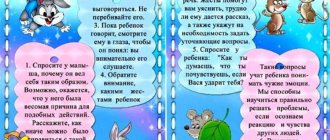MAGAZINE Preschooler.RF
Booklet “How to develop a child’s speech at home”“Kindergarten No. 117 “Ryabinka” , CHEET SHEET FOR PARENTS
teacher-speech therapist Ageeva Svetlana Vitalievna 2015, Kurgan
Development and improvement of speech sound culture:
On the recommendation of teachers, conduct special game exercises with the child to develop and improve the sound culture of speech as an integral part of preparing the child for subsequent literacy training.
To develop phonemic hearing, train the child to identify the first sound in his name, in the names of those around him, in the name of his favorite toy, and then in determining the sequence of sounds in these words; divide words into syllables and determine their sequence.
Monitor the correct stress when pronouncing words by playing games like “So and Wrong” : the adult pronounces words or phrases, combining the correct and incorrect use of stress, and the child listens and corrects the adult, pronouncing the word (phrase) with the correct stress.
Strengthen the pronunciation side of speech with the help of pure tongue twisters.
Development of the lexical side of speech:
Tell and show the child a lot, read educational literature, take him on excursions, and make observations. Carefully examine individual objects and items. In this case, it is advisable to take into account the cognitive preferences (interests) of your child.
Tell the child about relatives (where they live, who they work for, what wonderful people they are, how they relate to the child); about your work or study, about the people who surround you.
Continue the family tradition of daily conversations about the day. (What made you happy today? What made you sad? What surprised you? Etc.) Discuss and plan all joint activities with your child.
On the recommendation of teachers, conduct special speech games in order to enrich and improve the lexical side of the child’s speech.
Formation of grammatical structure of speech:
Exercise children in the correct use of verbs. Conduct speech games with your child like “Who can do what?” on the selection of verbs (for example: “What can a cat do and like to do? Run, sleep, lap, play, meow,” etc.); “Change the word” to the ability to use and form verbs with the prefixes u-, at-, you-, for-, pere-, under-, etc.
In everyday communication with the child, create speech situations that allow the child to coordinate nouns with numerals.
Monitor how the child uses complex forms of plural nouns in the genitive case.
Encourage the child’s desire to use complex types of sentences (complex and complex sentences) in speech.
In play situations, train the child in composing simple common sentences.
Development of coherent speech in children
Teach your child to be polite and tactful when participating in dialogue with adults and children. During conversations with a child, demonstrate a culture of dialogue. Show an example of how to conduct a dialogue at the table, at a party, when talking on the phone.
To consolidate the skills acquired in kindergarten in composing coherent monologue statements through: composing stories based on family photographs; stories based on a series of pictures; fairy tale retellings; compilation of elementary descriptions.
Encourage your child to try to compose fairy tales and stories. Monitor compliance with the rules for composing coherent statements. Play out children's compositions using theatrical means.
Starting from the age of five, children move to senior preschool age. This is the period of the child’s most harmonious state: many functions have already been formed, and at the same time, the crisis of seven years has not yet arrived, when the body begins to rebuild.
This is the best time of childhood!
Children of this age are inquisitive, independent and active. In this regard, their speech capabilities increase significantly, their vocabulary expands, and their speech becomes grammatically formatted and meaningful.
In order for a child to master oral speech in a timely and high-quality manner, it is necessary that he use it as often as possible, coming into contact with adults and peers.
“TO LEARN TO SPEAK, YOU MUST SPEAK!”
| Next > |
Logostales in the correctional work of a speech therapist
Logo tales in the correctional work of a speech therapist
Author: Radulova Svetlana Mikhailovna, teacher-speech therapist, Municipal Educational Institution “Bendery Kindergarten No. 9”, Bendery. Description of the material: I offer a report from the experience of a speech therapist teacher on the use of innovative technology - logostories in correctional work with children with speech disorders. The material will be useful to teachers and speech therapists of preschool institutions.
When working with children with speech disorders, a fairy tale is an effective developmental and correctional tool for the development of all aspects of speech. E.N. Vinarskaya notes that emotional discomfort negatively affects the development of all aspects of speech. Therefore, the speech therapist and teacher in joint activities need to ensure a positive attitude and maintain interest in the exercises being performed, consolidate and improve it in a new situation. A fairy tale is a good helper in this work. Methodological work with fairy tales has a long history. The term “fairy tale” first appears in the seventeenth century. The fairy tale was “mere fun”, worthy of the lower strata of society. Later, based on the research of B. Bettelheim, R. Gardner, C. Jung, V. Propp, a modern concept of working on a fairy tale was built. At the present stage, the method of working with fairy tales is being actively developed by many famous teachers and psychologists (T.D. Zinkevich-Evstigneeva, T.M. Grabenko, V.A. Gnezdilov, G.A. Bystrova, E.A. Sizova, T.A. Shuiskaya, M.A. Povalyaeva, etc.). The Institute of Fairy Tale Therapy, which was opened in St. Petersburg, is developing a methodology for complex work with fairy tales for children who have developmental disabilities. K.I. Chukovsky noted that adults think in words, verbal formulas, and small children - in things, objects. According to D. Rodari, “Fairy tales can help educate the mind, give keys to enter reality in new ways, can help a child get to know the world and gift his imagination.” Speech therapy fairy tales are those fairy tales that provide significant assistance in working with children experiencing difficulties in speech development. Logostales
are a holistic pedagogical process that promotes the development of all aspects of speech, the education of moral qualities, as well as the activation of mental processes (attention, memory, thinking, imagination).
Logo-fairy tales can be used by speech therapists and educators in their work with children with speech disorders. Fairy tales are taught as a whole lesson, didactic game, theatrical performance. A speech therapy fairy tale requires the active participation of children in the course of the story. The goal of a logos fairy tale is the comprehensive, consistent development of children’s speech and related mental processes through the use of elements of fairy tale therapy. Speech therapy fairy tales are simple in content, small in volume so that the child can understand their content and retell it. All work using logo tales is based on general didactic principles
: - systematicity and consistency, - taking into account age characteristics, - taking into account individual characteristics, - taking into account the structure of the defect, - stage-by-stage speech correction.
It is necessary to take into account the child's interest, joy, imagination, improvisation, emotional attention and memory. Using logo-fairy tales, its storylines can solve correctional problems
: – create a favorable environment for the child’s speech activity and creativity in order to increase the effectiveness of the play motivation of children’s speech;
- develop all aspects of the speech functional system in a form that is entertaining for preschoolers; – develop the psychological basis of speech, the relationship between the visual, auditory and motor analyzers; – to carry out the cooperation of the teacher-speech therapist with children and with each other on the basis of a personality-oriented model of interaction between participants in the educational process, to create an atmosphere of mutual understanding and mutual assistance. There are the following types of logostories
: 1. Articulatory (develop speech breathing, articulatory motor skills) 2. Finger (develop fine motor skills, graphic skills).
3. Phonetic (clarify the articulation of a given sound, automate, differentiate sounds). 4. Lexico-grammatical (enrich vocabulary, consolidate knowledge of grammatical categories). 5. Fairy tales that promote the formation of coherent speech. 6. Fairy tales for teaching literacy (introduce sounds and letters). Also distinguished: 1. Logostales of a didactic plan with the inclusion of various exercises, tests, performing tests, etc. (T. D. Zinkevich-Evstigneeva): - Articulatory. - Phonetic. — Fairy tales for teaching literacy. 2. Logo tales aimed at developing the polysensory ability of a child with speech impairment (“fairy tale” plus “objective activity”) (O. G. Ivanovskaya, E. A. Petrova, S. F. Savchenko): - Finger. 3. Logo-fairy tales-trainings, rich in certain phonemes, word forms, lexico-grammatical categories (author’s tales of speech therapist teachers G. A. Bystrov, E. A. Sizova, T. A. Shuiskaya) - Lexico-grammatical. 4. Logostales with modeled content (T. A. Tkachenko). — Fairy tales that promote the formation of coherent speech. Fairy tales are staged by different types of theaters
: - Finger Theater. Dolls, sewn or knitted, cut out of paper, are placed on the finger.
- Theater bi-ba-bo. The puppets are placed on three fingers of the hand and act on a screen or at a table.
- Shadow theater. Planar images of dolls or images of shadows using hands are shown on a lighted screen.
— Table theater. Cone theater puppets and plane figures act on the table.
- Theater of mittens. Children's mittens and gloves are put on the hand. -Toy Theater. The scenes are played out and shown to children with ordinary toys: soft, rubber, kinder surprises.
-Theater on flannelgraph. Planar images move on the flannelgraph.
Finger tales Finger tales: - stimulate the action of the speech zones of the cerebral cortex, which has a positive effect on correcting children’s speech; — improve mental processes: attention and memory, which are closely related to speech; — increase children’s interest in Russian folk tales and the small folklore genre. Teachers use finger gymnastics, individual games and exercises every day in class to develop fine movements of the fingers, which are accompanied by poetic texts. Such exercises are very emotional and simple. In order to interest children and avoid monotony in performing such exercises, finger games are combined into short fairy tales and stories on the same or different topics. The Tale of a Little Kitten
One day a little kitten went out into the yard
(The middle and ring fingers rest against the thumb. The index finger and little finger are raised up)
.
The sun was shining brightly in the sky (Palms crossed, fingers spread wide, forming “sun and rays”)
.
A rooster sat on the fence and crowed loudly (Palm up, index finger resting on thumb, remaining fingers spread out to the sides)
.
A hen and her chicks were walking around the yard (Palm up, index finger resting on thumb, rest of fingers bent)
.
Suddenly the kitten saw a large dog (The right palm is placed on the edge, towards itself. The thumb rises up. The index, middle and ring fingers are together. The little finger alternately lowers and rises
).
She began to growl loudly (pronounce: rrrr)
and the kitten ran away.
A duck with ducklings swam in the pond (Make smooth movements with the hands of both hands from right to left, then imitate the movements of the duck’s legs in the water
).
A goose walked importantly nearby (Place your hand with your elbow on the table, all fingers straight. Move four fingers, except the thumb, forward and press tightly together (“the goose’s head”). Lower your thumb a little down. It turns out to be a “goose” with an open “ beak")
.
A little goat was walking in a clearing (The index finger and little finger are put forward and move in different directions. The middle and ring fingers are pressed to the palm and clasped with the thumb)
.
He had small horns (the baby goat “butts”
), but the kitten was not afraid.
Suddenly, clouds appeared in the sky and rain started dripping: drip-drip-drip (Press the pads of your right and left hands to the table. Alternately tap them on the surface of the table, like playing the piano)
.
The kitten quickly ran home (Create a “roof” angle with the fingers of both hands, connecting them with pads at an angle. Connect your thumbs in a straight line)
.
Articulation fairy tales Complexes of articulation exercises are combined in the form of fascinating fairy tales about the Tongue. Such tales arouse children's interest in the organs of articulation, develop their mobility, and activate visual perception. All exercises in the fairy tale about the Tongue are performed in front of a mirror. The game character who creates a favorable emotional background in individual lessons is the frog Quackie. An adult puts the doll on his hand and asks him to perform articulation exercises. The child's interest increases while working independently with this wonderful toy.
In the “Theater of Fingers and Tongue,” the movements of the tongue are accompanied by synchronized movements of the hands, which act as assistants. Tale about a kitten (for hissing sounds)
The girl Masha had a fluffy kitten (
The middle and ring fingers rest on the thumb. The index finger and little finger are raised up)
.
Every morning Masha kneaded the dough (Open your mouth a little, calmly put your tongue on your lower lip and, smacking it with your lips, pronounce the sounds “five-five-five...” Hold your wide tongue in a calm position with your mouth open, counting from one to five to ten . Clench your fingers into a fist and spread them apart)
and bake pancakes (
Smile, open your mouth slightly, put the wide front edge of your tongue on your lower lip. Hold it in this position for a count of one to five to ten. Place the palms of both hands on the table and turn them over back side)
.
The kitten really loved pancakes with sour cream (Open your mouth slightly and lick your upper lip with the wide front edge of your tongue, moving your tongue from top to bottom, but not from side to side. Fold your palms into a “bucket”)
.
And Masha greased each pancake with jam (Open your mouth slightly and lick your upper lip with the wide front edge of your tongue, moving your tongue from top to bottom)
.
Masha poured tea into beautiful deep cups ( Mouth open. Lips in a smile. Stick the tongue out of the mouth. Raise the side edges and tip of the tongue, lower the middle part of the back of the tongue, bend down. Cup your palms)
.
The tea was hot, so the kitten blew on it and cooled it (Smile, open your mouth slightly, put the wide front edge of your tongue on your upper lip so that the side edges are pressed, and there is a groove in the middle of the tongue, and blow off the cotton wool placed on the tip of your nose. Air in this case, it should go in the middle of the tongue, then the fleece will fly up)
.
After breakfast, the kitten went outside for a walk. Phonetic tales Phonetic tales involve working on a disturbed sound or group of sounds. They select speech material based on automated sounds or differentiated sounds. In children with complex speech disorders, persistence of sound pronunciation defects is observed. To obtain sustainable results in working with such children, multiple repetitions of words and phrases for certain groups of sounds are required. Once in a logo-fairy tale, the child travels through it together with the main characters, helps in difficult situations, worries with them, supports them, and makes decisions. As a result, there is an unobtrusive consolidation of difficult sounds (automation of isolated sound, sound in forward and backward syllables, words, phrases, sentences, pure phrasing, poetry and in phrasal speech). Tales for teaching literacy Logostales: - introduce children to vowel and consonant sounds, - form the concepts: “sound”, “letter”, “vowel sound”, “consonant sound”; - develop auditory attention; - develop phonemic hearing; - introduce children to vowels and consonants, reinforce visual images of letters; - form and differentiate the concepts “sound - letter”. The main characters of fairy tales are sounds and letters, endowed with their own characters. During classes, children are immersed in the world of fairy-tale characters from the Kingdom of Sounds and Letters. Six glasiks (vowel sounds) live in the red palace. In the blue and green palace live consonants (consonant sounds).
Summary of a logo-tale lesson on teaching literacy “Sounds [v], [v']. Letter B" /blogs/svetlana-mihailovna-radulova/konspekt-zanjatija-po-obucheniyu-gramote-v-starshei-logopedicheskoi-grupe.html Lexico-grammatical tales Lexico-grammatical tales (G. A. Bystrova, E. A. Sizova, T. A. Shuiskaya) carry a certain lexical or grammatical load. Logo tales use various methods of enrichment, activation of vocabulary, word formation, and inflection. Fairy tales that promote the formation of coherent speech Types of work with fairy tales: 1. The child acts out familiar fairy tales. 2. Several children, having previously distributed the roles, act out a fairy tale. 3. The child acts out a fairy tale based on what he saw, but changes the characters, time, and end of the action. 4. The child acts out and models a fairy tale based on a set of toys offered or chosen independently. At the same time, the child independently demonstrates the fairy tale and comes up with its plot. Thus, the most complex form of coherent utterance develops - composing creative stories. 5. Preparation and presentation of musical and speech therapy tales.
Dramatizations of fairy tales activate the movements of the organs of the articulatory apparatus, form the lexical and grammatical structure of speech, develop general and fine motor skills of the fingers, coordination of movements, facial expressions, pantomime, mental processes (imagination, emotional-volitional sphere, attention, perception), creative abilities. Children develop melodic-intonation expressiveness, develop coherent monologue speech, and automate sounds in the text. The use of logostories in correctional work allows the speech therapist to establish emotional contact with the child, create a joyful mood in him, activate verbal communication, provide an unobtrusive educational impact, replenish the stock of knowledge and information, improve mental processes (attention, perception, imagination, memory, thinking), develop all aspects of speech. Literature:
1. Arkhipova E.F. Speech therapy work with young children. – M.: ACT. Astrel, 2006. 2. Zinkevich-Evstigneeva, T. D. Workshop on fairy tale therapy / T. D. Zinkevich-Evstigneeva. – St. Petersburg: RECH, 2001. 3. Ivanovskaya, O. G. Speech therapy tales for speech development: Fairy tales in nature-conforming education / O. G. Ivanovskaya, E. A. Petrova, S. F. Savchenko. – St. Petersburg: KARO, 2008.
We recommend watching:
Methodological development for fairy tale therapy Development of dialogic speech in compensatory groups Advice from a speech therapist teacher for parents Formation of the syllabic structure of words in children with special needs development
Similar articles:
Speech development in children 3-4 years old with developmental disabilities based on Suteev’s fairy tales
Booklet for parents “Fairytale therapy”
ADVANTAGES AND DISADVANTAGES
PROS:
1. Guaranteed effect.
If you tell the right fairy tale today, you can see the result the very next day!
2. Education without lectures.
A fairy tale about a child is the easiest way to gently correct a child’s behavior, carefully shape his character and not put pressure on his personality.
3. Many problems can be solved.
A fairy tale can help in many situations. Does the child not put away his toys, hurt other children, bite his nails, be afraid of the dark, or won’t let his mother go? Psychologists have identified dozens of situations that can be corrected with fairytale therapy.
MINUSES:
Children are individual, some kids like bright images, others may take some fairy-tale situation or character to heart. Therefore, it is worth taking a closer look at your child and explaining or slightly changing the plot twists so that the child listens to the fairy tale without unnecessary worries.
The booklet was prepared by teachers:
Sheremetyevskaya Anastasia Vyacheslavovna, Fefilova Lyudmila Leonidovna
Kindergarten No. 96
Arkhangelsk
2016
What is fairy tale therapy?
The term “fairy tale therapy” consists of two concepts: fairy tale and therapy.
. “Fairy tale” - oral stories, the word “therapy” means treatment of some kind of illness. Is it a little weird? Treat with the help of a fairy tale? What kind of disease is this? A fairy tale is pleasure, but can pleasure be a medicine?
So, fairy tale therapy
- This is not only a method of treatment, a fairy tale can be used both as an educational tool and in the process of teaching a certain subject.
"FAIRY TALE THERAPY" in various areas of human knowledge and experience:
- Fairy tale therapy
- a tool for transferring experience from mouth to mouth (this is a way of cultivating a special attitude towards the world, it is also a way of transmitting to a child the necessary moral norms and rules).
- Fairy tale therapy
- a development tool (in the process of listening, inventing and discussing a fairy tale, the child develops imagination and creativity, he
masters the basic mechanisms of search and decision-making).
- Fairy tale therapy
– psychotherapy (work with a fairy tale is aimed at treating and helping the client. The fairy tale therapist creates conditions where the client finds solutions to his life difficulties and problems).
How does fairytale therapy “work”?
1.Psychotherapists call a fairy tale a metaphor that allows you to look into a person’s inner world. In a fairy tale, each image has its own figurative meaning. Subconsciously, any person associates himself with a hero. Thus, a fairy tale can help you immerse yourself in your inner world, think about what interferes and what helps.
2. “Recognizing the problem and solving it” is great, but when it comes to ourselves, things are not so simple. A fairy tale in this case provides several invaluable opportunities:
— in a situation similar to our own, it is not we who find ourselves, but the main character;
— a fairy tale can turn back time, that is, a fairy tale allows you to play out several endings.
3. A fairy tale is an amazing world, it makes it possible to transform the inner and outer world, to see and accept its beauty and uniqueness.
4. We almost always associate any fairy tale with some pleasant memories.




